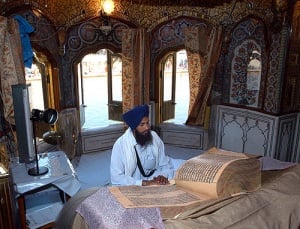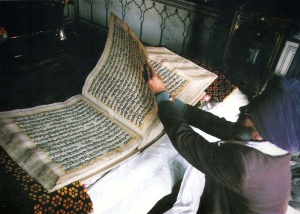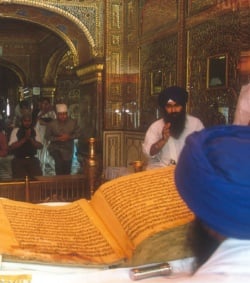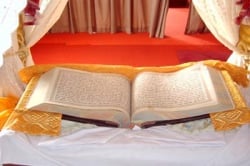Guru Granth Sahib
Guru Granth Sahib or Adi Sri Granth Sahib Ji (Punjabi ਗੁਰੂ ਗ੍ਰੰਥ ਸਾਹਿਬ; also called the Adi Granth or Adi Guru Darbar) is more than just a scripture of the Sikhs, for the Sikhs regard and respect the Granth (holy book) as their living Guru. The revealed holy text spans 1430 pages and contains the actual words spoken by the founders of the Sikh religion (the Ten Gurus of Sikhism).
Guru Granth Sahib was bestowed the Guruship by the last of the human form Sikh Masters, Guru Gobind Singh Ji in 1708. Before passing away, Guru Gobind Singh Ji decreed that the Sikhs were to regard the Granth Sahib as their next and everlasting Guru. Guru Ji said – “Sab Sikhan ko hokam hai Guru Manyo Granth” meaning “All Sikhs are commanded to take the Granth as Guru”. So today, if asked, the Sikhs will tell you that they have a total of 11 Gurus. (10 Gurus in human form, and the eternal shabad Guru, the Guru Granth Sahib).
Unique amongst the world's major religious scriptures, while compiling the Guru Granth Sahib, the Sikh Gurus incorporated not only their own writings, but also included the writings of other contemporary saints from Hinduism and Islam (including saints belonging to the lowest strata of untouchables in the Hindu Caste System), who believed in the unity of God and denounced superstition and caste. Further, the composition and compilation of the Guru Granth Sahib was performed by the Sikh Gurus themselves, rather than being performed by their adherents and followers, an aspect that has been highlighted by historian-scholars while discussing the authenticity of the preachings of the different teachers and prophets of the world, as known to mankind today.
When one visits a Gurdwara (a Sikh temple), the Guru Granth Sahib forms the main part of the Darbar Sahib or Main Hall. The holy book is placed on a dominant platform and covered in a very beautiful and attractively coloured fine cloth. The platform is always covered by a canopy, which is also decorated in expensive and very attractive coloured materials. The text in which the Granth is written is a script called Gurmukhi (literally "From the Guru's mouth"), which is considered a modern development of the ancient language called Sanskrit.
History & Composition of Guru Granth Sahib
Guru Nanak brought the Word of God to manifest upon Earth. Through his Hymns and Prayers (Shabads), he inspired and uplifted humankind to live a life of truth, righteousness and spirituality. These enlightening words were sung by his companions, Bala and Mardana, and by the Sangats (congregations) tha grew up around Guru Nanak. In his later years at Kartarpur, it became customary for the members of the Sikh community to sing certain hymns on a daily basis: Japji in the morning; So Dar and So Purakh, the beginnings of Rehiras, in the evenings.
Guru Angad, Guru Amar Das and Guru Ram Das all composed Shabads (hymns), and the Sikhs began to collect these in small books, called Pothis. Chanting these Shabads, the Sikhs became vehicles for the vibrations of the "Word of God", and they achieved a state of higher consciousness, a transcendent meditative union with God and Guru.
Standardisation of Shabads
Even early in Sikh history, however, there were mal-quotations, and pretenders to the Throne of Spirituality. The elder brother of Guru Arjun, Prithia, composed his own hymns and passed them off as writings of Guru Nanak. Although pothis existed of authentic Gurbani, there were many different collections of Shabads, and many differing versions of the same Shabads.
Guru Arjun realized that a standardized, authenticated collection of the Guru’s Bani (called Gurbani) was needed to preserve the integrity of the Shabad. The most complete collection of Shabads of Guru Nanak, Guru Angad and Guru Amar Das was in the possession of Mohan, a son of Guru Amar Das.
Retrieving the Pothi from Mohan
Guru Arjun sent Bhai Gurdas to Mohan’s home in Goindwal, to request this collection of Shabads. Mohan felt slighted at having been passed over for Guruship — his father, Guru Amar Das, had seen the Divine Light in Guru Ram Das, and had bestowed the Guruship upon him. Mohan refused to answer the door when Bhai Gurdas knocked, and Bhai Gurdas returned to Guru Arjun empty-handed.
Guru Arjun then sent Baba Buddha to Mohan’s house. Baba Buddha was by then a very old and respected man in the Sikh community, having been a disciple of all the Gurus, from Guru Nanak through Guru Arjun. When Mohan did not answer Baba Buddha’s knock, he entered the house anyway. Inside, he found Mohan in a deep meditative trance. Mohan’s younger brother convinced Baba Buddha not to disturb him, and Baba Buddha also returned to Guru Arjun empty-handed.
So it was that in 1603, Guru Arjun found it necessary to go in person to Mohan’s house, to retrieve the Shabads. When Guru Arjun approached Mohan’s house, rather than knocking he called out in a sweet voice, but there was no response. The Guru sat upon his doorstep and began to sing these lines:
- "Oh, Mohan, your mansion is so lofty, there is no other place like yours.
- Oh, Mohan, even the Saints adorn the door of your temple.
- Show compassion and kindness, Oh Kind Lord—be merciful to the poor.
- Says Nanak, I am thirsting for the Blessed Vision of Your Darshan, Grant me this gift and I shall be happy."
Mohan (in Punjabi) is one of the names of God, when calling upon Him as the Beloved. When Guru Arjun sang this Hymn, he was singing the Praises of God, in the form of a song to win Mohan’s heart. Mohan threw open the window and called out to Guru Arjun, "You stole the Guruship from my family, and now you come to steal what remains of my heritage!"
Guru Arjun responded with sweet words:
- "Oh Mohan, your words are like no others, and your behavior is exemplary.
- Oh Mohan, you believe in the One God and treat all others as garbage.
- Says Nanak, please preserve my honor - all your servants seek Your Sanctuary."
Mohan grumbled and protested, muttering about his claim to the Shabads. But finally, he came down and sat by Guru Arjun, as the Guru continued to sing,
- "Oh Mohan, the Sadh Sangat, the Company of the Holy,
meditates upon You, and yearns to obtain the Blessed Vision of Your Darshan.
- Oh Mohan, at the very last moment of life, death shall not approach You.
- All who worship You in thought, word and deed shall obtain Your Gifts.
- Even the impure, the stupid and the foolish obtain Divine Knowledge upon seeing You.
- Says Nanak, Oh God, You are present within all,
- You are above all."
Gazing upon Guru Arjun’s enlightened face, feeling the love and radiance emanating from him, hearing the sweet words of love and humility, Mohan’s heart was softened, and opened at last. He acknowledged Guru Arjun’s true place upon the throne of Guru Nanak, and gave all of the Shabads in his possession to Guru Arjun.
Work begins to compile the Adi Granth
Guru Arjun then set to compile the Shabads into a single volume, the Adi Granth. He sifted through the Shabads which had been passed down from the first four Gurus, and filtered out those which had been added by imposters. Bhai Gurdas Ji was the scribe who recorded the words of Guru Arjun. When he asked Guru Arjun how he could distinguish between the true and the false Shabads, Guru Arjun replied, "Even in a great herd of cows and calves, the mother cow will recognize the cry of her calf, above all others. Just so, the True Shabad resonates truly, and is easily distinguished from the false."
Guru Arjun added a great many of his own Shabads to those of Guru Nanak Dev Ji, Guru Angad Dev Ji, Guru Amar Das Ji, and Guru Ram Das Ji. He also added Shabads of thirty-six Hindu and Muslim Saints, among them Kabir Ji, Ravi Das Ji, Naam Dev Ji, Trilochan Ji, and Sheikh Farid Ji. This was the first time any religion incorporated the works of sincere devotees of other religions into its own scripture; this reflects the universality of thought which underlies the Sikh belief in One God, and the one family of humanity as children of God.
Guru Arjun left some blank pages in the Granth. When Bhai Gur Das asked the purpose of this, he answered that one of the Gurus to follow him would add the Shabads in their proper place at the proper time. In time the shabads of Guru Teg Bahadur, the ninth Manifestation of the Guru’s Light, were added by Guru Gobind Singh and thus the Siri Guru Granth Sahib was complete.
First installation of the holy Granth
The Adi Granth was completed in 1604, and installed in the Golden Temple; Baba Buddha was appointed Guru's Granthi. Guru Arjun told his Sikhs that the Adi Granth was the embodiment of the Guru, and should be treated in the same fashion as they respect him. When Guru Arjun first completed the Adi Granth, he placed it upon his own bed and slept on the floor. Its words were written without any spaces or breaks, which nowadays is hard for most people to follow.
Guru Gobind Singh, the tenth and last of the Sikh Gurus to take human form, dictated the entire Granth Sahib at Talwandi Sabo now called Damdama Sahib. Dhir Mal, the son of Baba Gurditta and grandson of Guru Hargobind, had taken possession of the Adi Granth; he refused to give it to Guru Gobind Singh when the Guru asked for it. Dhir Mal taunted the Guru, "If you are a Guru, then prepare your own."
Guru Gobind Singh recreates holy Granth
Guru Gobind Singh proceeded to dictate it to Bhai Mani Singh, who recorded it on paper. While some have questioned the authenticity of this story, it is well for us to remember that, of course, Guru Gobind Singh was no ordinary person at all. And, in the old days of bards and story-tellers, it was not unusual for them to recite from memory entire epic poems. Hajis, for example can recite the entire Qur'an and many Hindus priests could recite the Mahabarata. In a time when many people could not read or write, oral traditions were very important. The Sri Guru Granth Sahib is like the Qur'an and the Gita and is set in the form of music and rhythm making them much easier to remember.
Guru Gobind Singh included the Shabads of his father, Guru Teg Bahadur, but he did not include his own Shabads; instead, he placed them in a separate Granth, the Dasam Granth. The Dasam Granth is not revered as Guru, however. The great task of re-writing the entire Guru was finally completed in 1705. The "Damdama Sahib Bir" as it is now called was then taken to Nanded where it was installed.




